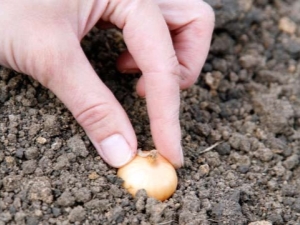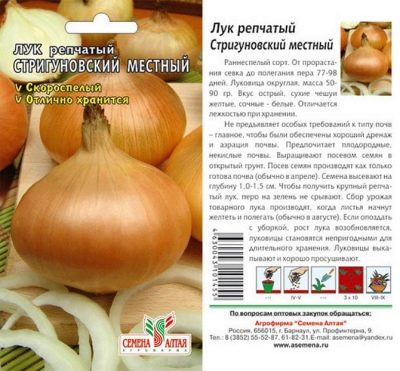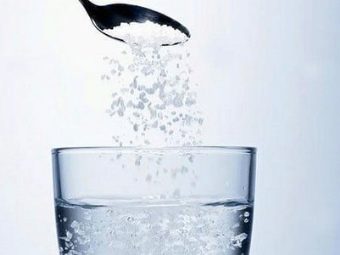Features planting onion sets in the regions of the Urals and Siberia

Any housewife wants to please her family with fresh herbs grown on their own garden bed.But the climate does not always allow it, many falsities arise in the conditions of the Urals and Siberia. It is worth considering how to get a rich harvest of onion sets, and what you need to do.
Climatic features
Ural and Siberia are important and very interesting climatic regions. The subarctic belt has a serious influence on the northern part of these regions, the rest of the area is influenced by a temperate climate. If we talk specifically about Siberia, then it is located simultaneously in such three climatic zones as:
- arctic;
- subarctic;
- moderate.
The borders of Western Siberia stretch from the mountains of the Urals to the Yenisei. Most of it has a continental climate. The weather can be called relatively stable when compared with the eastern or southern part. In southern Siberia, climatic conditions are very contrasting. For example, in winter it is clear, sunny and strong frosts, and in summer it is rather cool - approximately +21 degrees. It is hot and dry only in intermontane basins.
Based on these data, it becomes clear that in order to grow a culture in such a complex situation, you will have to put a lot of effort and patience.
Variety selection
According to reviews of gardeners, in these climatic zones, several varieties of onion sets are most suitable for breeding, since they have proven to be the best for growing in the region with so much contrasting climate. It is worth more to consider the characteristics of each variety.
- "Family". This variety is very juicy, aromatic, with a mild flavor. It can be stored for a long time, it is rarely affected by diseases and pests. This variety grows in nests, the weight of one nest reaches 300 grams.
- "Strigunovsky". This variety is spiced up early. The bulbs have a rounded shape, the flesh is white inside, the color of scales outside is pinkish or grayish. The size is not large, the mass of bulbs makes 45–80 grams. Taste - with moderate sharpness.
- "Arzamas". Adult bulbs reach a weight of 100 grams, the shape is elongated, the color outside is yellow. In terms of ripening, this variety is among the mid-ripening.
- Yukont. This is a ripening variety and at the same time it is deadly. The bulbs are purple, their taste is pronounced, spicy. Fruit weight reaches 120 grams.
- "Black Prince". This variety is included in the list of mid-season varieties with a mild flavor.
- "Ermak". This type is included in the category of precocious. It is stored for a long time, the weight of a single bulb can exceed 200 grams. Outside, the color is golden.
- "Siberian Annual". This variety is stored for a long time, refers to the early maturity. On average, it is ready to eat 2 months after planting. The bulbs have a flat shape, the taste of the pulp is soft, without pronounced sharpness.
- "Myachkovsky 300". This bow-sevok was zoned purposefully for the conditions of the Ural region. From the time of planting to readiness to eat, it takes about 90 days. Bulb weight can reach 110 grams, the taste is semi-sharp, the variety is universal.
- "Exhibition". This variety is medium cold resistant. Bulbs are large, can reach 700-800 grams. Taste is sweet, pulp of white color.
- "Botherus". The bulbs are long-term storage, they weigh up to 800 grams. The taste is sharp, the shape of the bulbs is rounded.
- "Carmen MC". This is a relatively new variety that is grown as a two year old. In the nest a maximum of three onions, the taste is weakly sharp.
- "Bessonovsky local". This is a type of early ripening. The flesh is white, the keeping quality is high.
- "Sturon". This variety is the result of the hard work of Dutch breeders. Maturing time is about 100 days after the first shoots appear. He is not afraid of frost, harsh winters endure perfectly. When storage conditions are observed, onions retain their freshness for 7–8 months.
- Timiryazevsky. This type of sevka was excluded from the State Register, but it continues to be popular with gardeners. It harnesses quickly, it is easy to save in the winter.
- "Buran". This is a universal variety grown by growers from Siberia and the Urals. It is characterized by high resistance to bacterial infections, increased keeping quality.
- Red Baron. Hue bulbs purple, saturated. The average weight of 1 onion is 110–120 grams. The taste is soft, well kept in winter.
Timing
It is difficult to talk about specific sowing dates, since the weather conditions in these regions are unstable, often there are changes in temperature and humidity. Therefore, it is necessary to observe one of the most important conditions: before sowing onions in the spring in open ground, you should monitor that the temperature does not fall below + 5– + 10 degrees for several days. The best time is the beginning of May. When choosing favorable days for planting, it is necessary to focus on the growing season of the selected variety. For different varieties, they look like this:
- early - 90 days;
- middle ripening - 110 days;
- late ripening - 120 days.
Seed preparation
After buying immediately plant a vegetable is not recommended. The bulbs should be laid out in a warm room and dried well. Important: for drying you can not use radiators of various types, as well as lay the bow directly on the radiators. If the onion sets are prepared independently, then more thorough preparation is required.
Storage temperature should not exceed + 18– + 20 degrees. When the time for sowing is chosen, the onions are heated at +40 degrees for 10 hours, without exceeding this limit. This method allows you to enhance the growth process, prevent bolting.
Another important stage is soaking, for which Fitosporin can be used, as well as a solution of salt and potassium permanganate. The technique allows for thorough disinfection of planting material. In particular, soaking in salt contributes to such goals as:
- acceleration of germination;
- disease prevention;
- destruction of pest larvae;
- raising the immunity of plants.
"Fitosporin" is used to protect plants from the following diseases:
- powdery mildew;
- phytophthora;
- rust;
- bacterial rot.
If you do not want to spend time soaking, you can spray the bulbs with a solution and let them dry. Potassium permanganate also gives its effect: all microorganisms that were in the planting material die. This method is quite cheap and effective, which explains its popularity. In general, the algorithm for preparing the bow for planting is as follows:
- first onions sifted through and discarded dried or rotted specimens;
- then the onions are sorted according to size, since large bulbs should be planted first.
To enhance immunity, the bulbs can be hardened. To do this, they are soaked for 15 minutes in warm water, and then just as much time in cool water. After such contrasting trays, you can place the planting material for 5–6 hours in a solution of a mineral fertilizer that you like.
How to plant?
It is worthwhile to consider how the proper planting of the onion sets is carried out in order to grow a rich and healthy crop. Before planting onions, it is not enough to treat only planting material, the soil also requires attention. To place the onion beds choose an open place, which receives a sufficient amount of sunlight. It should be borne in mind that the presence of excess moisture is unacceptable. The deeper the groundwater, the better. Well, if you can follow the rules of crop rotation.
For example, suitable predecessors for sevka are the following:
- potatoes;
- cabbage;
- tomatoes
It is possible to plant carrots not far from the onion, but it is not worth sowing the onion directly after it. In the role of predecessors, garlic, carrots and cucumbers are also not perfect.By the way, you do not need to plant on those beds where other varieties of onions grew before. The beds should be cooked in the autumn - the soil is loosened, peat is brought in, and lime is used if necessary. But it is not necessary to introduce lime and organic at the same time, because of this, the nitrogen content in the soil decreases.
It is not necessary to make fertilizer in the spring, otherwise only his feathers will grow well. It should simply loosen the soil and you can start planting after the soil is fully heated.
Directly, the process of planting a bow set includes the following important steps:
- before disembarking on the ridge it is worth noting the rows, which will make it possible to understand how much bow will be needed to sow a specific area.
- large and small bulbs should be planted separately, since for each size its own planting scheme is used;
- do not bury the bulbs deep, which complicates germination; it is enough just to stick them in the bottom with soil and lightly press them.
Experts recommend keeping a distance of about 20–30 cm between the onion beds. The distance between the bulbs should also be kept at 15–20 cm. After planting, the soil on the garden bed can be mulched. If you follow all these simple rules, the growth of the bulbs will be normal, they will not interfere with each other. After about 7–10 days, mulch can be removed.
Garden beds require regular and thorough weeding. Because of the weeds in the ground, the amount of moisture that the onions do not need is increased, because it will provoke the development of rot. The first time the dressing can be made 14 days after planting, it is recommended to use for this purpose a mullein infusion. The second time you can apply fertilizer only after 21 days. As for mineral fertilizers, they can be used in dry form or as a solution. They make one time for the entire season.
Speaking of watering, it is worth noting, while the growing season has just begun, watering onion sets twice a week in the absence of rain. From the beginning of July, watering is reduced, and 14–20 days before the start of harvesting from the bed, it is generally stopped.
After watering, the soil should be loosened so that oxygen is supplied to the roots. Care must be taken not to form a hard crust on the garden bed. After the bulbs begin to fill, it is worth a little to otgresti ground from them.
If the onion does not grow well and the feathers have a pale color, this indicates a lack of nitrogen. If the leaves have a gray tint, the plants are clearly low in potassium. And it is also worth noting that, contrary to popular opinion, onions do not spud. Onion sets are susceptible to root rot, fungal infections and powdery mildew. In addition, it is attacked by thrips, nematode and onion fly. As soon as the first visual signs of defeat appear, it is necessary to undertake to save the crop, otherwise there is a risk of losing the harvest. It should be used according to the scheme of insecticides and biofungicides, safe for people and animals. The sooner you start fighting with various diseases, the more effective it will be.
There are a number of other problems, but they can be easily fixed if the care is adjusted on time, including the following:
- leaves turn yellow early - too dense plantings, little moisture or defeat onion fly;
- the bulbs do not ripen - too much nitrogen in the soil;
- the bulbs die early - little moisture, strong thickening;
- bolting - it can only be prevented by drying.
It is better to harvest the crop before heavy rains begin, as they provoke repeated rooting, which is not possible to stop
Gardeners tips
When planting onion sets, you should adhere to the following tips and recommendations from gardeners with experience:
- when sorting onions, you should always get rid of those who have at least a small speck of rot;
- you should not raise the temperature of heating the bulbs yourself;
- Before planting, the material should be dipped into the solution of copper sulphate and planted in the ground without washing;
- do not plant onions in the cold ground;
- do not forget about the timely cessation of watering;
- It is not recommended to cut feathers from a bow and turnip, which reduces yield;
- do not break the leaves;
- when you will remove the onions for the winter, you should cut the neck a few centimeters;
- first of all, the largest bulbs should be used, since they cannot be preserved for a long time;
- It is not recommended to use fresh manure for feeding, because it provokes the appearance of a large number of weeds.
Grow onion sets in the Urals and Siberia is quite real. This, of course, is slightly more difficult than in the southern regions, but it is possible. It will only be necessary to select the optimum sowing time and follow simple rules in care.
Onions are a picky culture, but certain conditions must be met, then the result will exceed all expectations.
In the next video you are waiting for the subtleties of planting onion sets.



































